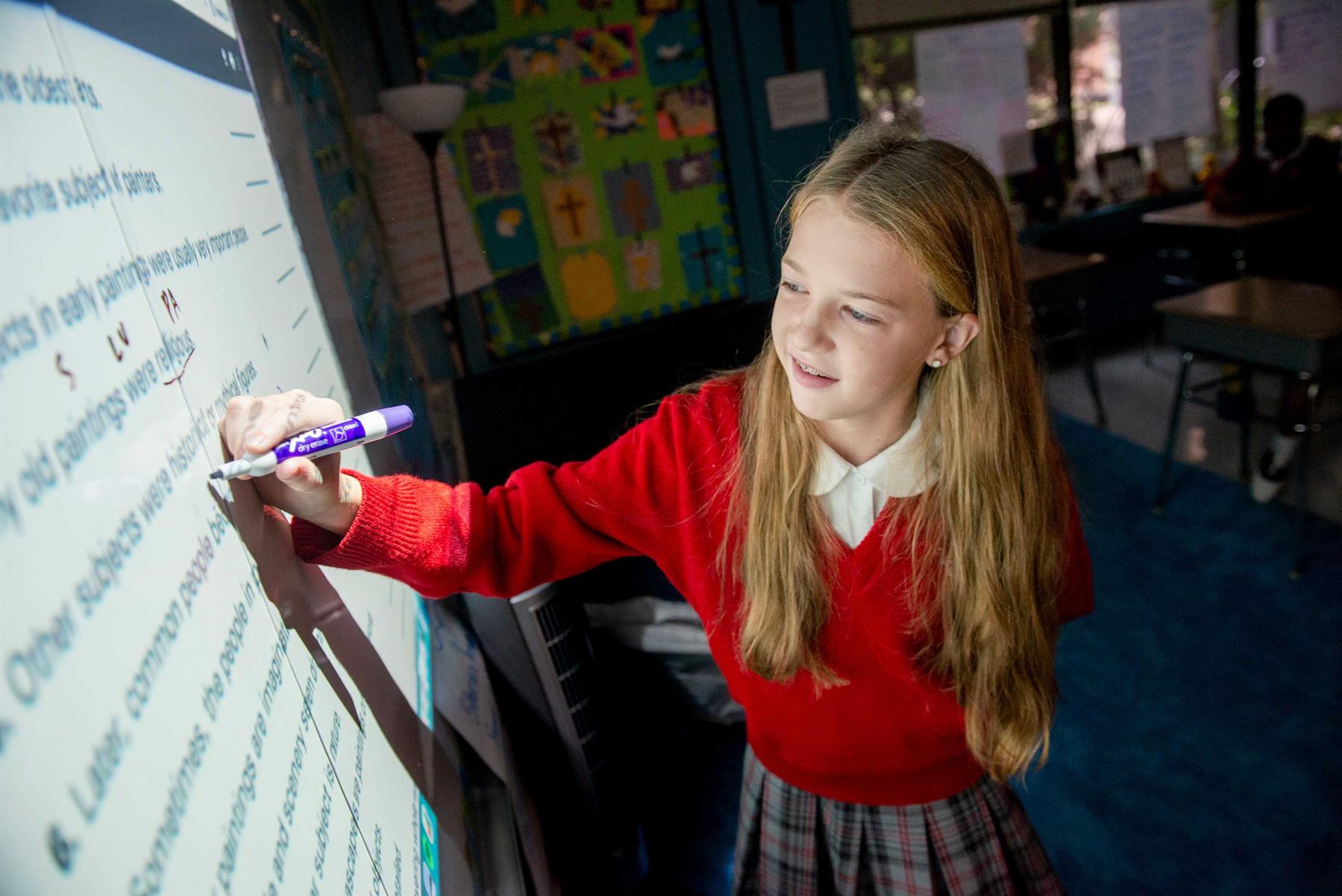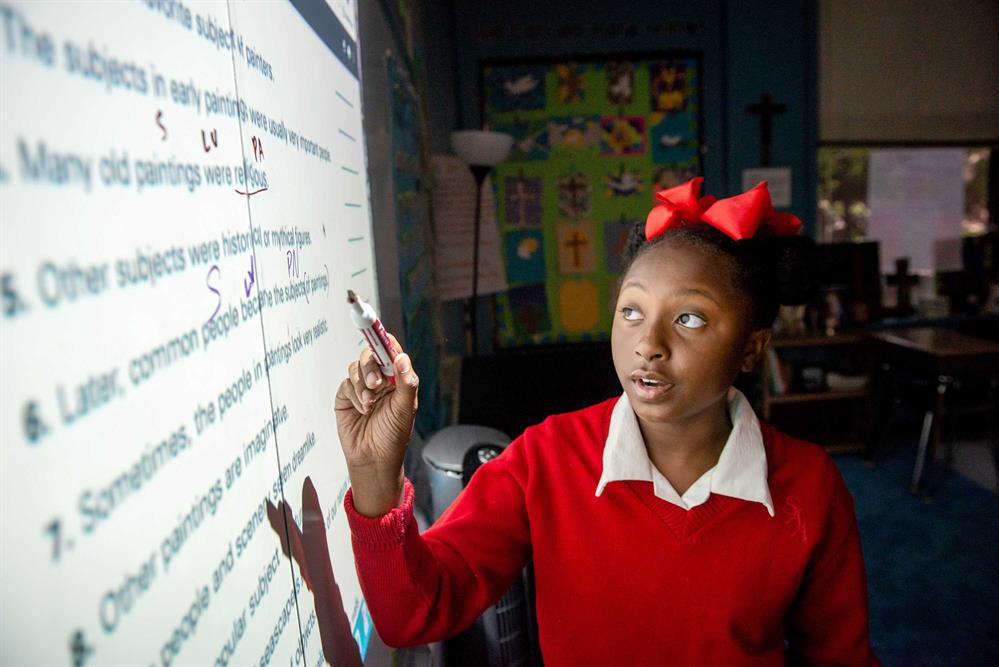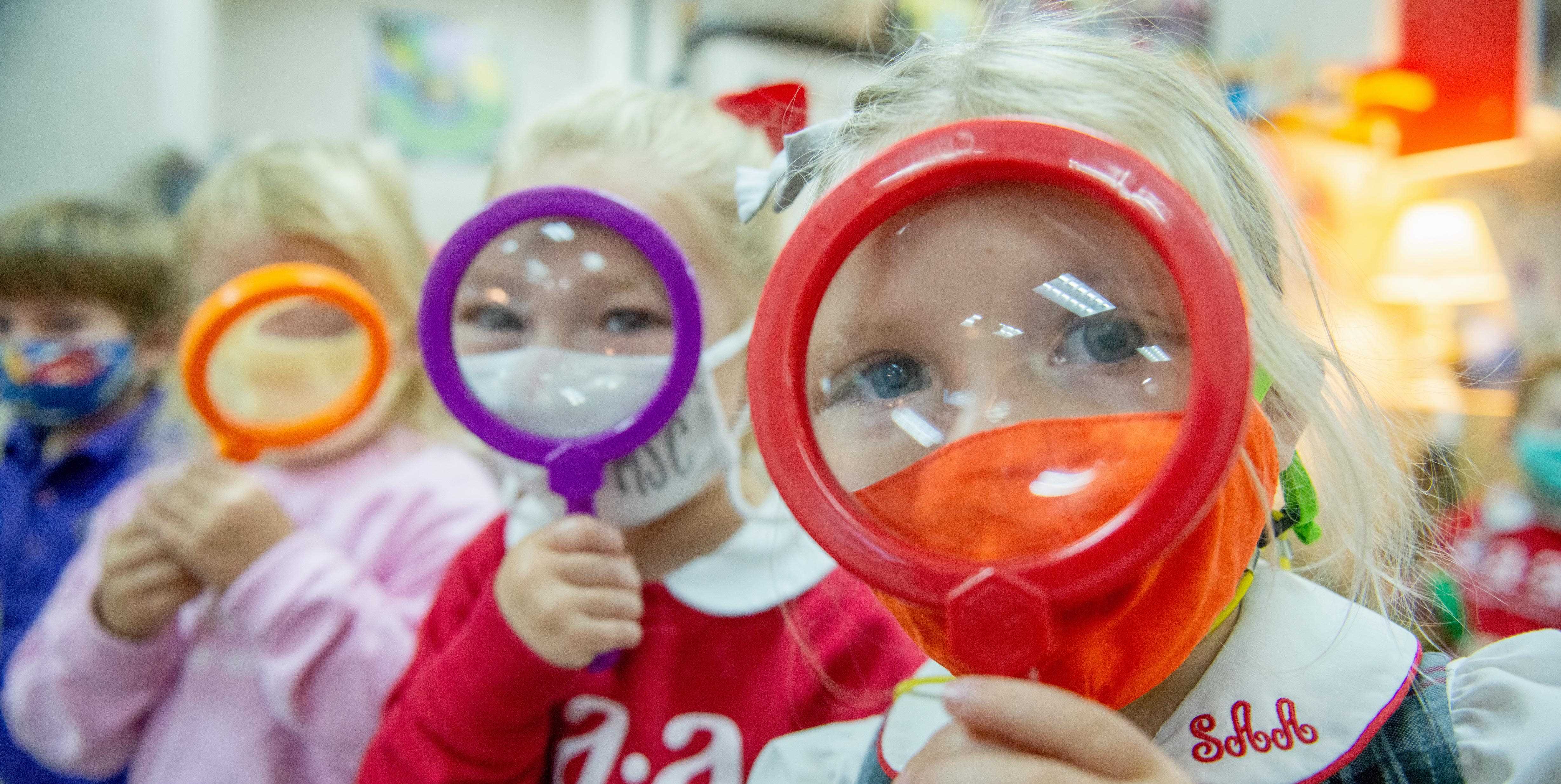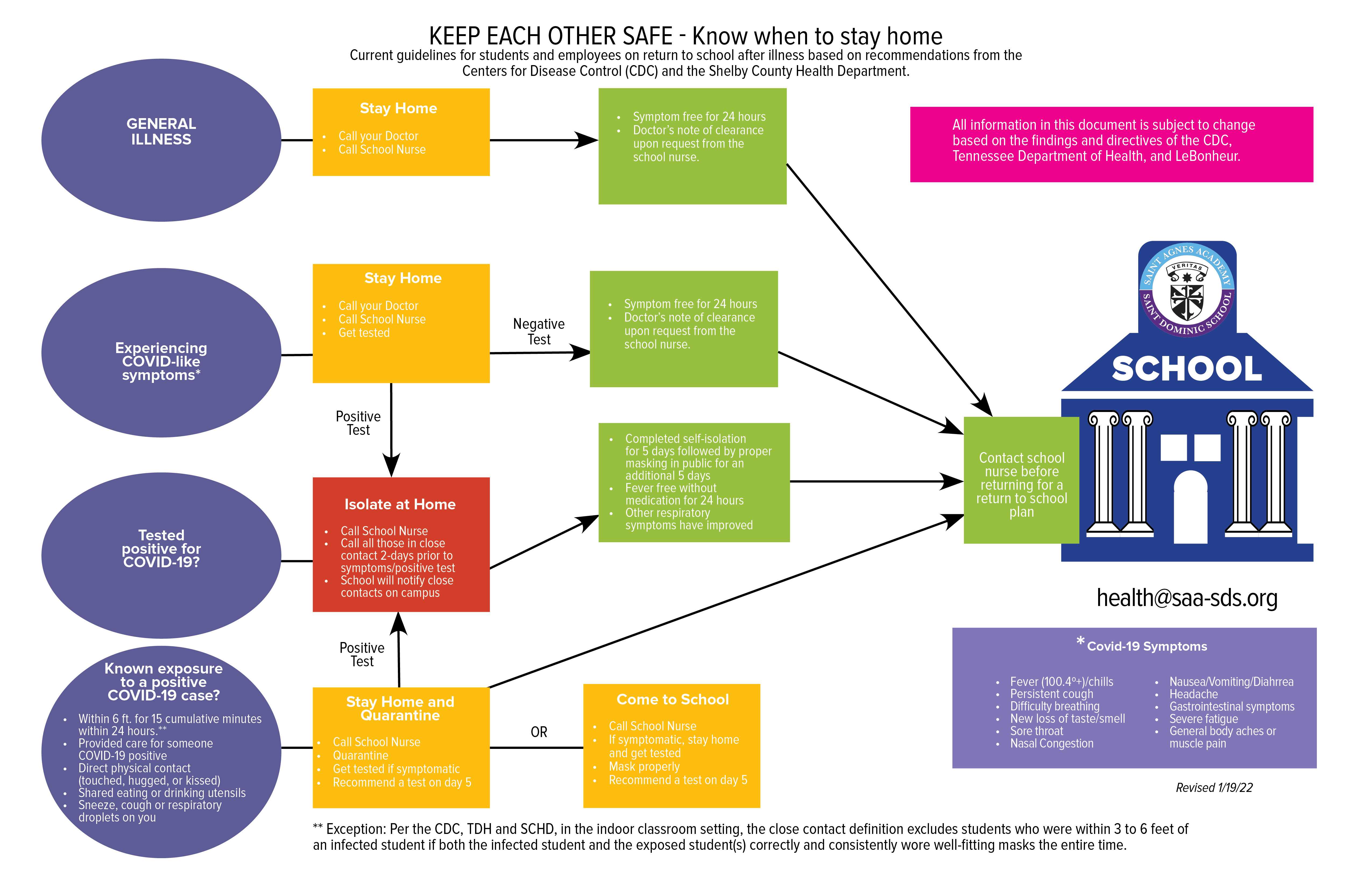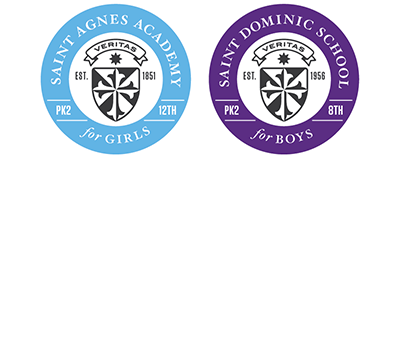
Health Plan
COVID-19 Health Plan
St. Agnes Academy – St. Dominic School
The purpose of this policy is to outline the St. Agnes Academy-St. Dominic School Health Plan during the COVID-19 pandemic. The CDC, TN Department of Health, Shelby County Health Department, and LeBonheur Children’s Hospital guidelines have been carefully considered and adapted to address and promote the safety, health, and welfare of our students, faculty, and community. Criteria may become more or less restrictive moving forward, depending on the most current guidelines. This is a working document and all information is subject to change.
NOTIFICATION:
To help us track any illness, please contact the administrative assistant associated with each school division. If your student is going to be absent for illness, absent for any other reason, or check-in late, please notify the following people:
- NURSE - Sandra Miller & Nina Gardner health@saa-sds.org
- ECC - Emily Morton emorton@saa-sds.org
- SAA LS - Tammy Brooks tbrooks@saa-sds.org
- SDS - Diane Pirozzi dmpirozzi@saa-sds.org
- SAA-SDS JH - Tammy Brooks tbrooks@saa-sds.org
- US - Renata Novarese rnovarese@saa-sds.org
Please be sure that parent contact numbers as well as approved persons to pick up your student in case of illness or emergency have been updated with the school as well as the emergency information form given at registration. Depending on the severity of the illness or injury, the nurse will contact an emergency contact person for the child if unable to reach the child’s parent(s) first.
GENERAL ILLNESS:
Students who feel ill or present symptoms of illness should not come to school. Tylenol, Advil, Ibuprofen, Aleve, Excedrin or any other fever-reducing medications should not be administered prior to school in the event that it masks symptoms. If a student or staff needs to miss school for symptoms of any illness, we request you notify the appropriate division office and the School Nurse by email (see above contact information).
Should a student or staff present symptoms for any illness while at school, we will escort the student to a comfortable isolated area, and they will be seen by our school nurse for evaluation. The school nurse will contact the parent and the Dean regarding steps taken and whether the student or staff needs to leave campus.
Students or staff should not come to school if they are exhibiting any of the following symptoms:
- Temperature of 100.4 degrees or higher
- Nausea and/or Vomiting and/or diarrhea
- Strep throat
- Unexplained rash
- Skin infections
- Undiagnosed redness or swelling of the eye
- Severe congestion with or without a cough
- New onset severe headache, especially with a fever
Students or staff may return to school when the following parameters are met:
- 24 hours after last episode of vomiting and/or diarrhea
- 24 hours fever free without the use of fever reducing medications such as acetaminophen (Tylenol) or ibuprofen
(Advil, Motrin) - Antibiotic therapy for a full 24 hours for bacterial infections (such as pink eye, strep throat, or other bacterial infections)
- Cold symptoms are mild enough so as not to interfere with participation in school activities or infect others.
- 24 hours after being discharged from an emergency department or hospital
- A healthcare provider’s note must be present for severe skin infections clearing student to return to school
- Doctor’s note of clearance with a date of return upon request from the school nurse when requested.
St. Agnes Academy – St. Dominic School will continue to support students with acute or chronic health conditions. Short- term absences will be handled on a case-by-case basis with the parent in touch with school officials. Long-term absences will be considered if criteria is appropriate for medical leave or other potential medical accommodations.
COVID-19 SYMPTOMS:
COVID-19 symptoms may appear 2-14 days after exposure to the virus and typically include:
- Fever or chills
- Cough
- Shortness of breath or difficulty breathing
- Fatigue
- Muscle or body aches with unknown cause
- Headache
- New loss of taste or smell
- Sore throat
- Congestion or runny nose
- Nausea or vomiting
- Diarrhea
This list does not include all possible COVID-19 symptoms, and with the Delta and Omicron variant even minor cold or allergy symptoms cannot be ignored. Children and adolescents with COVID-19 may experience any, all, or none of these symptoms. Therefore, in order to rule out COVID-19, the school reserves the right to request a COVID-19 test before returning to campus.
When determining a need for testing the school will take into consideration whether or not the student was in close contact with a COVID-19 positive individual as well as the community transmission rate. If a student has symptoms but has not had a close contact, then the school will take into consideration the risk of transmission in the school and community. (If there was no close contact, then the student will stay home until symptoms improve, per general illness policies.)
PENDING COVID-19 TEST:
If a student/staff member has a pending COVID-19 test result, they should NOT come to campus.
Exceptions are:
- Testing without known exposure or symptoms
- Testing prior to a medical procedure or surgery
- Testing of employees on a regular basis without exposure/symptoms, example: St Jude employee, healthcare workers.
- Fully vaccinated asymptomatic individuals.
POSITIVE COVID-19 TEST (Isolation):
Any student or staff with a positive COVID-19 test should stay home and NOT come to school. They should stay at home, isolate in accordance with CDC guidelines, email the school nurse, and contact those individuals deemed in close contact 2 days prior to being symptomatic or 2 days prior to testing.
For the safety of the school community and to help stop the spread, we ask that you notify the school of any other school community members that would be affected by your positive test. Parents should notify the Shelby County Health Dept. if someone in their household (adults and school-aged children) has a positive test. Sick teachers or staff should do the same.
If staff or student is COVID-19 positive and symptomatic, return to school may occur after:
- 5 days since symptoms first appeared AND
- Symptoms improving and 24 hours fever-free without the use of fever reducing medication AND
- Contact the school nurse prior to returning for an assessment and return to school plan which will proper masking for an additional 5 days.
If staff or student tested positive for COVID-19 but had no symptoms, return to school may occur after:
- 5 days have passed since positive test AND
- Contact the school nurse prior to returning for an assessment and return to school plan which will include proper masking for an additional 5 days.
The School Nurse must be notified prior to faculty or student’s return to school to discuss return to school plans. Please email health@saa-sds.org to discuss a return to school plan which will include properly wearing a mask on campus through day 10.
CLOSE CONTACT (Quarantine):
A parent may choose to keep a child at home or send them to school following an exposure. A student who has been exposed to a positive case, but is not experiencing any symptoms, may remain in school, regardless of vaccination status. Testing on day 5 from exposure is highly recommended. The student must be properly masked for 10 days following last exposure to minimize the risk of infecting others. If symptoms appear, the student should stay home, get tested and contact health@saa-sds.org.
VACCINATION:
All students/faculty/staff who have been vaccinated or have started the vaccination series (Moderna or Pfizer) are asked to please email the following information to immunizations@saa-sds.org: Name, vaccination name (J & J, Moderna, or Pfizer), date of last shot, and if your child participates in a sport.
TESTING:
If an individual who is ill with symptoms of COVID-19 has a doctor’s note confirming the illness is not due to COVID-19 but another diagnosis confirmed by lab results (i.e. strep with positive strep test, mono, UTI) then that student/staff may return to school at the discretion of the doctor after being fever free for at least 24 hours and symptoms have improved.
However, if the diagnosis is a respiratory and viral condition that cannot be confirmed by a lab test (i.e. upper respiratory tract infection (URI), pneumonia (without a chest x-ray), sore throat without positive strep test, viral illness, sinus infection, seasonal allergies, etc) the student will not be able to return to school without a negative COVID-19 test.
If not COVID-19 tested, the student/staff will be considered as positive and will need to isolate for 5 days from the onset of their symptoms AND be fever free for at least 24 hours AND symptoms have improved before returning to school. A doctor’s note of clearance with a date of return may be needed upon request from the school nurse.
At this time, only nasal swab test results are accepted by the school for a COVID-19 like illness. While a send-off PCR swab is the most accurate test, a rapid antigen or a rapid PCR are acceptable. COVID-19 antibody blood tests are not accepted by the school.
The school reserves the right to request a medical note of clearance with a date of return for any illness. We will always make decisions based on the safety of our school community.
PRESENTING COVID SYMPTOMS AT SCHOOL:
Should a student or staff present with symptoms related to COVID-19, we will assess them in a pre-designated, comfortable area within the school division building, and based on our determination, we may ask that the parent or guardian pick them up within 60 minutes. A rapid antigen COVID test can be administered on campus with parental consent. In the event that a student is sent home due to COVID-19 symptoms or a positive COVID-19 test, the siblings of the ill student or children of the ill staff will be sent home as well when deemed necessary by the school nurse. For an Upper School student who drives, parents will be notified that the student is departing campus.
CONTACT TRACING:
If a positive COVID case is identified on campus during school hours, or if the school is notified of a positive case that has been on campus within the last 48 hours, the following steps will be taken by the Health Team to perform contact tracing and to communicate with the members of our community who are affected:
POSITIVE CASE IDENTIFIED ON CAMPUS
- Positive individual is isolated in a safe, comfortable environment and will be masked. Parent/guardian is called to pick up child within 60 minutes. Close contacts (individuals within 3-6 ft for 15 cumulative minutes in a 24 hour time period) during the individual’s infectious period (48 hours prior to symptoms or positive test) are identified through positive individual’s interview, faculty/staff interviews, lunch contacts, seating charts, carpool/transportation contacts, sports/extracurriculars, etc.
- An email from leadership will be sent to those families affected with further information regarding the 10-day exposure period, optional quarantine, testing guidelines, and masking protocols.
POSITIVE CASE REPORTED AFTER SCHOOL HOURS, BUT WITHIN 48 HOUR INFECTIOUS PERIOD:
- Close contacts during the individual’s infectious period (48 hours prior to symptoms or positive test) are identified through positive individual’s interview, faculty/staff interviews, lunch contacts, seating charts, carpool/transportation contacts, sports/extracurriculars, etc.
- An email from leadership will be sent to those families affected with further information regarding the 10-day exposure period, optional quarantine, testing guidelines, and masking protocols.
- To help make the contact tracing process smoother in this situation, we ask that any positive individual, please notify individuals they feel are considered a close contact in the SAA-SDS community.
COMMUNICATION:
SAA-SDS is committed to keeping the lines of communication open and to working together with parents to ensure the safest possible environment for your child. In an effort to keep our community informed, we have created a COVID Dashboard that can be accessed in the Parent Portal and in Schoology Parent Resources that reflects positive cases on campus. This dashboard is updated daily.
If your child is deemed to have been in close contact with an individual who has tested positive, the school will notify you via email or phone call. The school will send an email notification when there is a positive COVID case in your child’s division. Emails will be sent with the subject line COVID-19 Class Update. Due to privacy regulations names will not be shared.
St Agnes Academy-St Dominic School has created a COVID-19 Support Team that is ready to provide assistance for our families. This team includes members of our health, counseling, faith, and academic departments. They will be working in coordination to ensure the physical, academic and emotional needs of our students and families are being cared for. Should your family need support during this time, please reach out to us.
DEFINITIONS:
*Close Contact is defined as any individual who was within 6 feet of an infected person for at least 15 cumulative minutes in a 24 hr period starting from 2 days before illness onset OR, for asymptomatic patients, 2 days prior to positive specimen collection, until the time the patient is isolated.
Close Contact includes:
- You were within 6 feet of someone who has COVID-19 for at least 15 cumulative minutes within a 24 hr period.**
- You provided care at home to someone who is sick with COVID-19.
- You had direct physical contact with the person (touched, hugged, or kissed them.)
- You shared eating or drinking utensils.
- They sneezed, coughed, or somehow got respiratory droplets on you.
**Exception per the SCHD: In the K-12 indoor classroom setting or a structured outdoor setting where mask use can be observed, the close contact definition excludes students who were between 3 to 6 feet of an infected student if both the infected student and the exposed student(s) correctly and consistently wore well-fitting masks the entire time.
Cluster: a COVID-19 cluster is two or more confirmed or probable cases of COVID-19 that are linked by the same location of exposure (e.g., hospital, long-term care facility, grocery store, etc.) or exposure event (e.g., work party, vacation, etc.) that is not a household exposure.
Coronavirus: a specific type of virus named for the appearance of crown-like spikes on their surface. There are seven known types of coronaviruses that can infect human beings. A “novel” coronavirus is a new subtype of coronavirus to which human beings have not been previously exposed and are thus more susceptible to infection. SARS-CoV-2 is a novel coronavirus.
COVID-19: abbreviation of “Coronavirus Disease-2019”. The name for the actual disease state caused by the coronavirus. COVID-19 and SARS-CoV-2 are often used interchangeably, though this is inaccurate. The term “COVID-19” should be used to discuss the disease, while SARS-CoV-2 should designate the virus itself.
Epidemic: an outbreak of disease that spreads quickly and affects many individuals at the same time.
Fever: technically defined as a body temperature of 100.4° F or higher.
Fully Vaccinated: In general people are considered fully vaccinated if within the last 6 months they meet one of the criteria:
Two or more weeks after they have received a booster shot, OR
Two or more weeks after they have received the second dose in a 2-dose series (Pfizer-BioNTech or Moderna), OR
Two or more weeks after they have received a single-dose vaccine (Johnson and Johnson [J&J]/Janssen)
Herd immunity: resistance to the spread of a contagious disease within a population that results when a sufficient number of persons are immune either through prior infection and recovery or through vaccination. Herd immunity does not begin to develop until at least 60-70% of the population has been infected and recovered.
Incubation period: the duration of time it takes for an infected person to begin to physically manifest symptoms that can be outwardly observed.
Influenza virus: another specific type of virus from a different family than coronaviruses. There are several types of influenza viruses, of which only three typically cause infection in humans on a seasonal basis.
Isolation: medical isolation refers to confining a confirmed or suspected COVID-19 case to prevent contact with others and to reduce the risk of transmission. Isolation separates sick people with a contagious disease from people who are not sick.
Low-grade temperature: classified as an oral temperature that is above 98.6° F but lower than 100.4° F for a period of 24 hours.
Pandemic: a specific type of epidemic — the outbreak of widespread disease — that spreads over greater geographic distances and affects an exceptionally high proportion of the population. Pandemics are relatively rare events, and not every epidemic qualifies as a pandemic. The World Health Organization declared the SARS-CoV-2 outbreak a pandemic in March 2020.
Quarantine: separates and restricts the movement of people who were exposed to a contagious disease to see if they become sick. These people may have been exposed to a disease and do not know it, or they may have the disease but do not show symptoms.
Severe Acute Respiratory Syndrome-Coronavirus-2: abbreviated as SARS- CoV-2, the scientific name of the coronavirus causing the pandemic.
Social Distancing: also referred to as physical distancing, means keeping space between yourself and other people outside of your home.
Vulnerable Individuals: 65 yrs or older; underlying medical conditions, unvaccinated individuals regardless of age.
USEFUL LINKS:
Releasing Cases and Contacts from Isolation and Quarantine - TDH
https://www.tn.gov/content/dam/tn/health/documents/cedep/novel-coronavirus/Isolation-QuarantineRelease.pdf
Quarantine and Isolation Guidelines - CDC
https://www.cdc.gov/coronavirus/2019-ncov/your-health/quarantine-isolation.html
Quarantine and Isolation Calculator - TDH
https://covid19.tn.gov/prevention/quarantine-isolation-calculator/
Return to School Algorithm - TDH
https://www.tn.gov/content/dam/tn/health/documents/cedep/novel-coronavirus/TDH_Return_to_School_Algorithm.pdf
LeBonheur FAQ’s
https://mcusercontent.com/98e00013cd446bc8c2c44c8fa/files/ea20c350-3e7e-441d-297d-a6a825e6b58d/JAN_2022_FAQ.01.pdf
SAA-SDS Health and Safety Task Force
health@saa-sds.org
Revised January 16, 2022
There remains epidemiological uncertainty, a lack of established precedent, and insufficient data to make recommendations that entirely remove risk from returning to school. It is likely that, despite the implementation of all the recommendations and safety protocols, staff and students may still be infected and develop COVID-19. The risk cannot be eliminated. All requirements set forth in this document are meant to provide children, teachers, and staff with an environment that promotes safe practices for being in the classroom, moving about the school and during activities, and limiting the amount of coronavirus in the air.


